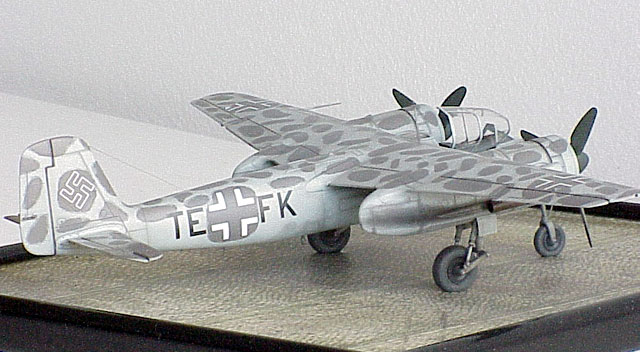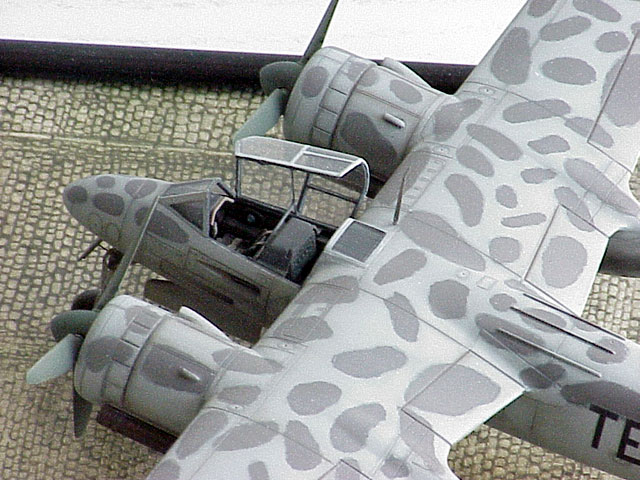|
Focke-Wulf Ta 154
by Andrea Mariottini
|

|
|
Focke-Wulf Ta 154 |

Hasegawa's 1/72
scale Ta 154A-0 is available online from
Squadron.com
Here is Hasegawa's 1/72 Focke-Wulf Ta 154, slightly modified to
represent the V7 prototype that differed from previous prototypes in
having the night fighter camouflage.
The V7, coded TE+FK, was fitted with armament but had no radar. The
absence of radar retains the clean lines of the nose that I like so much
when represented enclosed between the two spinners (as I tried to show
in some of my photos) even if the lack of lateral visibility due to this
feature was not a favourable feature from the pilot's point of view!

The V7 was utilised for high-speed flight and handling trials but the
low level of production quality control delayed the tests.
The kit is very good and the fit of the parts is excellent. The model
did not require any filler and permits the fuselage and the wing to be
painted separately before gluing them together.
I only made a few minor improvements:
-
replaced the thick canopy of the kit with
a thinner hand made one
-
reproduced the small karmans (missing in
the kit) between the engine nacelles and the lower part of the wing
-
cut and repositioned the control surfaces
-
replaced and/or added minor items like
details in the cockpit, pitot tube, antennas, brake fluid pipes and so
on.
The model was entirely hand painted in acrylic Aeromaster RLM 76. The
outlines of the Gray Violet mottle were drawn using a grey pastel. This
allowed me to carefully reproduce the position, the size and the shape
of each patch following the photo on page 13 of the Monogram Close-Up n.
22.
All the surfaces to be kept in RLM 76 were then masked using Humbrol
Maskol; and a thin coat of Gloy's RLM 75 was sprayed on the upper
surfaces of the model (believe it or not, but the Gloy enamel is 30
years old and still good).

When the color was dry, the Maskol was peeled off. As consequence the
edges of the patches were sharp. In order to restore soft edges the
outlines of the patches were drawn again with the grey pastel. Excess
pastel powder was removed by using a soft brush from the edge to the
centre of the patch.
Panel lines, weathering and exhaust stains were added using pastels.
For more details, see also my short article about my pastels technique.
The decals are from the box. The only exception is the "K" letters that
have been cut from a black decal sheet.
-
Monogram Close-Up n. 22
-
Air International Vol. 36 n. 4 April 1989
(4 photos of the V7 are present)
-
le Fana de l'Aviation n. 222/223 May/June
1988
-
Luftwaffe Warbirds Photo Album n. 4 1993
and n. 5 1994
-
Flugzeug Vol. 4 n.1 February/March 1988
-
Replic n. 99 November 1999
Click on the thumbnails
below to view larger images:
Model, Images and Text Copyright © 2002 by
Andrea Mariottini
Page Created 02 May, 2002
Last Updated 04 June, 2007
Back to HyperScale
Main Page
Back to
Features Index
|
Home
| What's New |
Features |
Gallery |
Reviews |
Reference |
Forum |
Search